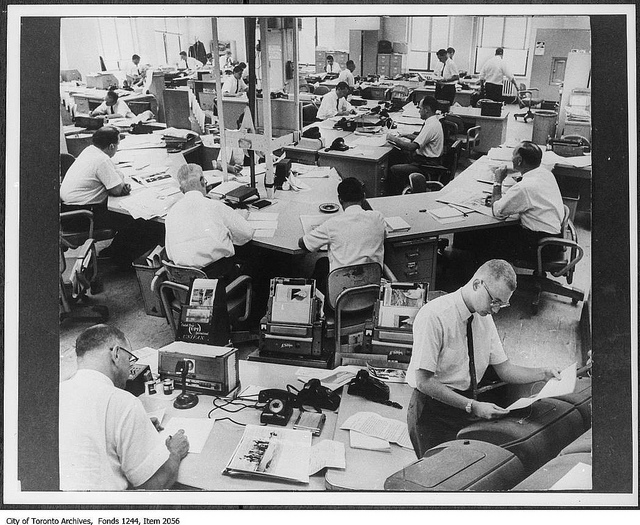Like our coverage of digital media? rabble is reader-supported journalism. Chip in to keep stories like these coming.
People don’t actually read newspapers. They step into them every morning like a hot bath. — Marshall McLuhan
If Marshall McLuhan had been able to spend any time with the new Star Touch iPad application, he might have changed that aphorism to: “People don’t actually read iPad news applications from the Toronto Star, they bounce around inside them like a caffeinated tourist in Time Square.”
If you’re not familiar with the product, Star Touch is TorStar’s big gamble on a digital future. It is a free, iPad-only app that totally repackages Toronto Star content for an Apple tablet audience. The newspaper publisher purchased the technology and launch expertise of La Presse, which launched the app platform as La Presse+ in April 2013. La Presse spent about $40 million developing the interactive news platform. TorStar is its first customer for the platform as it moved, this year, into being not just a news provider on the software, but a vendor of it to other publishers. Star Touch launched its version on September 15, at a cost of at least $10 million.
La Presse (owned by Power Corp.) is very aggressive about moving its audience to tablets. The day after Star Touch launched, and three years after La Presse+ was born, La Presse announced that come January 1, 2016, La Presse will only publish a print edition on Saturdays. Its weekday print publication will be dead.
Power Corp. is quite happy to leave its non-tablet audience behind (an Android tablet version is coming soon). It considers tablet owners the high-value customers advertisers yearn for, and, well, democratizing access to information be damned.
The Toronto Star is taking a more relaxed view, more Atkinson Principles stance, and intends to keep its print publication around for the foreseeable future. But, while print editions of both publications are supported by paid subscriptions, both apps, for now, are free and subsidized by a wide variety of interactive advertising. So, it will be interesting to see how long Atkinson stands up to advertising in the new model.
For many readers, especially older readers, the cellulose edition of both papers remain McLuhan’s warm bath. But, in many ways, Star Touch is more like a hot mess.
As I mentioned in passing in last week’s column, the Star Touch product lifts TorStar out of the fray of increasingly gaudy, annoying ads that piss off audiences and garner a shrinking return per eyeball.
In turn, the app gives advertisers a whole new collection of ad units to entice readers with. Promoters can get ads that pivot, pirouette, slide, carousel, flip or accordion. Readers can shake, scratch, unfold, twist or turn them. The ads can be delivered by location or by time of day. It’s surprising they can’t put out the cat, make coffee and shine your goddamned shoes.
In short, the tablet-based news app is an advertiser’s playground. Unfortunately, that cornucopia of interactive ad choices is bad for readers in a few ways.
First, that dizzying array of interactive options has leaked into the user experience of the app. There is no way of knowing, once you click on a Star Touch story, which particular flavour of story interactivity you’ll be greeted with. Do you swipe a story, flick a story, play a video, flip through a slide show, pick a story part from a confusing selection of menu tabs? It’s as if you tap a story and spin the big interactive prize wheel deep inside the app.
Second, the all-singing, all-dancing ads very often act like Hotel Californias, or roach motels for unsuspecting readers. It is very easy to stumble into, say, a multi-page ad for Kinky Boots and have no idea how to get back to the story you were just swiping or flicking your way through.
Third, the ads are hardly a respite from a web choked with annoying ads. They’re just as annoying, they’ve just learned to tap dance and be annoying.
I wish I liked Star Touch more, I really do. I know La Presse spent millions and years researching and developing it. I love the fact that it is almost an artisanal product, lovingly handcrafted each day by real journalists. It is a manifestation of a medium I dreamed of back in the ’90s, a tablet-based newspaper for the future. I must be more careful what I wish for.
Because, here’s what bothers me the most. I know it wasn’t made for readers, it wasn’t made for the thousands of readers without tablets, and it wasn’t made for the more desirable ones with tablets. And, it wasn’t made for journalists. Yes, they will have myriad and rich new ways of telling stories. But when you’re only telling stories to an audience your advertisers want most, your stories change.
And, of course, the real customers for the app are the advertisers. They’re paying, so they get to pay the piper and call the tune. And then they get Star Touch to dance to it, Kinky Boots and all.
Listen to an audio version of this column, read by the author, here.
Wayne MacPhail has been a print and online journalist for 25 years, and is a long-time writer for rabble.ca on technology and the Internet.
Photo: Toronto Star newsroom ca. 1964. Credit:Norman James/Toronto History/flickr
Like our coverage of digital media? rabble is reader-supported journalism. Chip in to keep stories like these coming.



